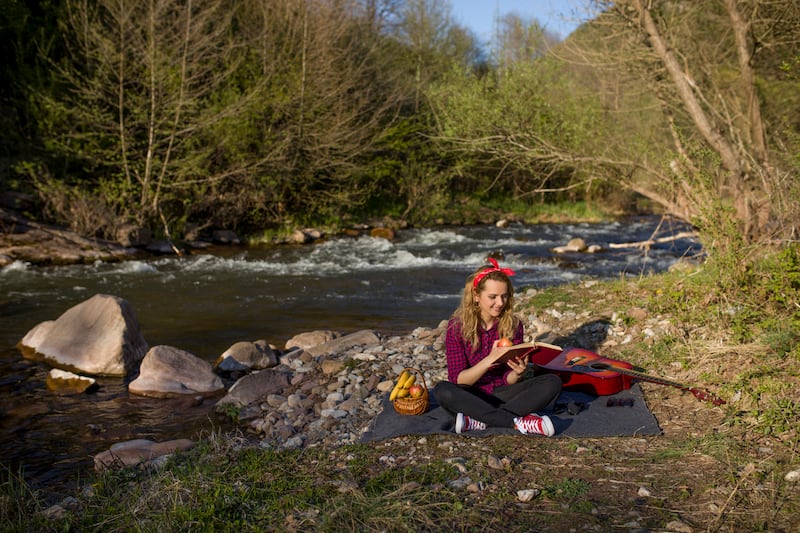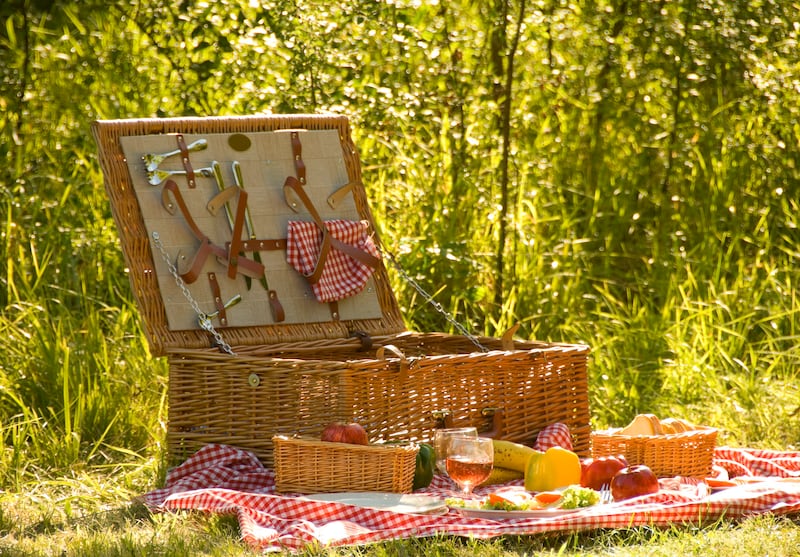Love it or loathe the wasps and lack of toilets, the outdoors is where it’s at this summer if you want to socialise in (relative) safety. That means picnics are going to take on a greater significance. Which raises a question: how can we up our picnic game?
Streamline and strategise
“Take as little as possible. That’s the big mistake people make: too much kit,” says Ali Ray, the author of The Picnic Book. A picnic blanket is a sensible investment (“an old curtain won’t protect you from a wet bum”) or physically distancing friends could each bring a tote bag with a small cushion in it to sit on.
“But, seating aside, Ray suggests having a simple, compact picnic kit, stowed and ready to roll, consisting of a cool bag; sharp knife (folding, non-lockable with a blade less than 7cm long is advisable, legally); small chopping board; napkins; old scarf to lay food on; and, possibly, some forks and cheap melamine plates.
Put the chopping board flat at the bottom of the cool bag to give it shape. Or roughly insulate a rucksack with two old newspapers and throw in an ice pack to create a cool bag. “I’ve also got one of those granny trolleys, which is spot on for loading everything in,” says Ray.
Foodwise, you don’t need lots. But you do need items that combine well and can be easily served and eaten. Panic-buying at the local petrol station is likely to be more expensive and less satisfying than, for instance, investing in some decent bread and ham or spending an hour making a couple of salads and one key item (a frittata, coronation chicken or a hollowed-out and filled crusty picnic loaf).
“Sanitiser and wet wipes are a must,” adds Saima Khan, the chef-founder of the Hampstead Kitchen, in London. “Don’t forget music and a portable charger.”

Be decisive
The perfect picnic spot, that immaculate glade by a clear stream, mainly exists in movies. You can waste a lot of time looking for it. Set up promptly. “People get so grumpy walking too far, especially kids,” warns Ray.
Make sandwiches on site
“I wouldn’t take sandwiches,” says Sam Herlihy, who runs a sandwich shop. They may get squashed or clingfilm sweaty in transit. “Build them in situ. That’s the move.”
Given the logistical challenges of keeping things consistently cold or warm mid-picnic (note: a cold Scotch egg is a tragedy), use sandwich ingredients, such as cheese and charcuterie, whose flavours come alive as they warm.
“People probably eat cheese too cold and have meats straight from the fridge. Warming them is not a bad idea,” says Herlihy, who recommends using olive oil rather than butter to lubricate the bread. “It’s practical, and butter feels weird if the sun’s shining.”
Rather than lugging a cool box along, a cool bag or that improvised rucksack chiller should suffice. There are DIY workarounds, too
If making sandwiches beforehand, Maria Whitehead, of the Hawkshead Relish company, recommends using frozen bread, so that the sandwich defrosts, but stays cool for a period. Rick Toogood, chef-owner at Prawn on the Lawn, in Cornwall, transports filled baguettes in Pringles tubes. “Guarantees a perfect sandwich.”
Zero-fuss finger food
From chef Vivek Singh's samosas ("They work well hot or cold") to Yotam Ottolenghi's harissa-spiced tuna picnic cake ("Tuna mayonnaise, potato salad, boiled eggs, rolled into one"; the full recipe is at the end of this article), there are endless foods that, once made, are a cinch to serve at picnics. No plates. No cutlery. Pre-portioned. Self-service.
Ryan Blackburn of the Old Stamp House restaurant, in Cumbria, makes a “what’s in the fridge?” kind of tortilla, frying chorizo, sliced onion and garlic, cubed potato and any suitable veg, before adding four beaten eggs and – just as it sets – cheese, and then bunging it under the grill. “Let it go cold and slice into wedges, ready to cart off the next morning.”
Ravinder Bhogal, who runs the London restaurant Jikoni, loves stuffed parathas on picnics. Hot or cold, they hit the spot. “My favourite stuffing of late is, untraditionally, kimchi and mature cheddar. The dough takes up the kimchi juices while the cheese mellows everything out, especially if you’ve a feisty kimchi.”
Strengthen salad
Combine robust ingredients that, unlike a leafy green salad, retain their integrity and look appetising after being jostled in a container. Pasta, potato, grain and bean salads hold up, as do firm, non-watery vegetables such as fennel, radish, carrot, grilled courgette or cabbage.
To avoid any unappetising sogginess, Ray brings her salad dressings in old screw-top spice jars and deploys them as she serves.

Essential extras
Travelling light is a relative concept. Good condiments are probably more essential than quality food. Milli Taylor, the author of Party Perfect Bites, is currently obsessed with Lao Gan Ma crispy chilli oil. “It’s my picnic essential: a chilli oil like no other, which packs a big flavour spooned over potato salad, shop-bought hummus or cold soba noodles.”
From sweet chutneys to salsa verde, each has its picnic advocate. A step up is Khan’s preference for packing toppings, such as crumbled feta, lemon zest and pomegranate seeds, which guests use to jazz up her lamb chops or grilled vegetables.
Chilled-out drinking
Rather than lugging a cool box along, a cool bag or that improvised rucksack chiller should suffice. There are DIY workarounds, too. Foil wrapping (first layer reflecting in, second out), should keep a bottle of chilled white wine sufficiently cool for a couple of hours. Likewise, a six-pack of cold beers wrapped tightly in two carrier bags. On the beach, digging a beer hole will also help.
Organised drinkers will have various “wine sleeves” in the freezer, ready to slip around a chilled bottle. Some, such as Vacu Vin’s well-reviewed Active Cooler, will chill warm bottles down (various stockists, about €12).
Currently leading virtual tastings at thewineworkshop.club, the wine expert Jane Parkinson is precisely that sort of organised drinker. But in an emergency, she will pop an ice cube into a glass of white. “It’s controversial – 10 years ago I’d have gone: ‘Ridiculous!’ But now I’d rather have cold wine.” Parkinson’s other hack is to chill white wine to near freezing – don’t shatter the bottle – before leaving, so it’s still cold on an arrival.
Wine choice
By insisting on very cold white or rosé at a picnic, are we making life hard for ourselves? Instead, should we be drinking lightly chilled red? Most red wine is served too warm and many “low-tannin, fresh, juicy” reds (beaujolais, other gamays, pinot noir, Austrian zweigelt wines) will be “perked up” by refrigerating them before you set out or sitting them in a stream while you drink. “If it’s cooler than people are used to, that’s no bad thing, as long as it’s not some delicate old burgundy,” says Parkinson. And if it warms up a bit over the day, it’s not a disaster. “On temperature, red wine has the least chance of disappointment.”
Parkinson is a traditionalist on glassware. She loathes plastic cups, “paper is dodgy” and carefully wraps stemless tumblers for picnics. “To me, glass makes a complete difference to how wine tastes.”
Thermos cocktails
Flasks keep liquids hot (Nina Matsunaga, chef at the Black Bull Inn in Cumbria, mentions the “top picnic cheat” of taking instant ramen noodles and a Thermos of hot water), but their ability to keep exciting things cold, such as cocktails, is less celebrated.
You could batch, chill and transport negronis, says the cocktail ace Jack Wakelin. “Use equal parts gin, Campari and sweet vermouth to two parts water.” Or try a “simple, bittersweet, light” americano. Take 125ml of Campari, 125ml of sweet vermouth and five halved peaches, microwave together for one minute and cool. Strain and add 750ml of chilled soda water. Refrigerate the americano for an hour before pouring it into a flask.
Disposable barbecue tips
Please grill responsibly (no scorched grass, no lit grills in park bins), and, if possible, invest in EcoGrills which, instead of plastic-wrapped, fuel-soaked charcoal in a throwaway aluminium pan, are made from 100 per cent biodegradable alder wood and claim a 2½-hour cooking time (various stockists, from €10). In contrast, says Jackson Bristow, chef and live-fire cookery expert at Cornwall’s Nancarrow Farm, after the coals have turned white, cheaper disposables may offer just 20 minutes of “optimum” cooking time.
Go for thinner and/or smaller cuts of meat, advises Bristow, minute steaks, butterflied chicken breasts or marinated meat skewers. Leave a third of the grill surface free, too, to maintain airflow. You could even steam fish on there. Seal the fillets in tinfoil tents with white wine, lemon, herbs and garlic, and, depending on the fillet’s thickness, they should cook in 10 to 15 minutes.
Recipe: Yotam Ottolenghi’s harissa-spiced tuna picnic cake
This glorious cake is tuna mayonnaise, potato salad and boiled eggs all rolled into one. It’s best made a day ahead, so it has plenty of time to set in the fridge, but four hours should do the trick, if need be.
Preparation: 10 min
Cooking time: 1 hr 20 min
Setting time: 4 hr+
Serves: 6
Ingredients
For the picnic cake
750g small to medium new potatoes
Flaked sea salt and black pepper
7 eggs
100g mayonnaise
1tbsp dijon mustard
240g tinned tuna in olive oil, drained
4 spring onions, finely sliced
200g pitted kalamata olives, roughly chopped
300g cherry tomatoes, halved
60ml olive oil
3tbsp harissa, or less, depending on your taste for spice
2tsp maple syrup
For the parsley salsa
1½tbsp flat-leaf parsley, finely chopped
1 lemon – zest finely grated, to get 1 tsp; and juiced, to get 1½ tbsp
1 garlic clove, peeled and crushed
2 tbsp oil
1 big pinch flaked salt and black pepper
Method
1 Heat the oven to 200 degrees. Put the potatoes in a medium saucepan of cold, well-salted water. Bring to a simmer, then cook for 25 minutes, until the potatoes are soft but still hold their shape. Drain and set aside to cool.
2 While the potatoes are cooking, half-fill a large saucepan with water, bring to a boil, turn down the heat to medium-high so the water is boiling gently, then lower in five eggs and cook for six minutes. Drain, leave the eggs under the cold tap for a couple of minutes, to stop them cooking any more, then peel and set aside. Whisk the mayonnaise with the remaining two eggs and the mustard.
3 Line the base and sides of a 20cm cake tin with greaseproof paper. Lay out the potatoes on a chopping board and squash them flat with a fork or potato masher, so they're about 1.5cm thick. Put half the squashed potatoes in the base of the tin, pressing them very firmly together to form a compact layer. Sprinkle with a little flaked salt and pepper, then top with half the tuna, half the spring onions and half the olives. Pour half the mayonnaise mix evenly over the top.
4 Cut the soft-boiled eggs in half lengthways, and lay them yolk side up on top of the spring onions.
5 Top with a final layer each of tuna, spring onions and olives, in that order, then lay the remaining squashed potatoes on top, pressing them down to form a compact layer. Sprinkle with salt and pepper, then pour over the remaining mayonnaise mixture and press the whole thing down very well to compact it.
6 Toss the tomatoes with the harissa, maple syrup and two tablespoons of oil, and scatter evenly on top of the potato layer.
7 Place a tray under the cake tin to catch any oil, then bake for 35-40 minutes, until the tomatoes have softened and are slightly charred. Refrigerate until cool and set, for at least four hours, and preferably overnight.
8 Mix the parsley salsa ingredients, remove the cake from the tin and drizzle evenly with parsley salsa. – Guardian









